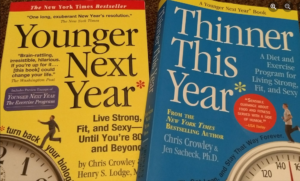Special to Financial Independence Hub
When I started riding my stationary bike about a year ago, I had a vision of what exercise would do for me. I’d become a stronger, healthier person. I’d lose weight. My desk would be tidy and my bookshelves in alphabetical order. I’d be taller. I’d be younger.
That last goal was inspired by a book called Younger Next Year, by Chris Crowley and Henry S. Lodge, MD. They wrote that, although everyone is going to die, years of decrepitude at the end of life are avoidable. There was a way to counteract the relentless decline of aging. Unfortunately, the only way to release the rejuvenating chemical was daily physical exertion.
As a woman of a certain age, I no longer focused on whether exercise would help me look good naked. Instead, my goal was to be able to get to the bathroom by myself well past the age of ninety. Caring for my elderly mother, I learned that being able to drive a car isn’t the key to independent living. It’s being able to get to the potty on your own.
One benefit of the stationary bike was its convenience. On my morning commute from the bedroom to the kitchen, I passed the exercise room and could hop on the bike.
I bought my stationary bicycle second hand for $40. I felt frugal saving thousands of dollars compared to the latest high-end stationary bikes. Those gorgeous new machines had a screen that makes it look like you’re biking in the Tour de France or across Tuscany. Or you could take a virtual spin class with a live instructor.
But what those high-tech bikes couldn’t do was distract me from the fact that I was working out. Exercising wasn’t fun for me. I needed distraction. My riding times improved considerably when I started watching Netflix on my tablet. I wanted to peddle vigorously while catching up on episodes of Capote and The Swans. I wanted to forget that I’m on the bike and just have the minutes tick by.
My goal was to ride for an hour. At first, if I rode fifteen minutes, I was exhausted: breathing hard, awash in perspiration, and rubber-legged my first few steps after climbing down. But I kept increasing my time a few minutes each day.
The hour-long ride eluded me for months. At fifty minutes I’d stop and tell myself that I could have ridden for another ten minutes if I really wanted to. Then I pushed through to fifty-five minutes.
When I finally rode a complete sixty-minute hour, it was a huge victory. I jumped off the bike, pumping my fists over my head as I did the Rocky dance. My cat looked at me like I was nuts.
Elated, I called my cousin to brag. “I biked for an hour today.”
“You did?” she said. “You’re an animal.”
“I’m an animal!” I shouted.
My cat shot me a look that seemed to say, “Leap to the top of the refrigerator, then tell me who’s an animal.” But I was in no mood to yield the field. I had done what the go-getters in spin class dog: I rode for an uninterrupted sixty minutes.
As hour-long rides became my routine, some things changed. I could talk on the phone while I was riding. My recovery time became much shorter. My legs wanted to dance, which could be embarrassing if I was standing in line at the bank.
Things that DIDN’T improve with regular exercise
But my life hadn’t become perfect. Here are a few things that didn’t improve with regular exercise.
I didn’t lose weight
Okay I lost a little, but only when I started dieting. They say that anyone can lose weight if they take in fewer calories than they burn. But the math wasn’t my friend: it was too easy to eat more than I could possibly work off. I could blow two days of biking with a cheeseburger, let alone a hot fudge sundae. I had become more fit but I wasn’t an athlete who could eat anything.
My sleep pattern didn’t improve
I still frequently woke up in the wee hours of the morning. The only difference was that I fell asleep at 9 pm instead of midnight. My insomnia persisted.
My mood didn’t elevate
Endorphins sound great, but I’ve never experienced a runner’s high. I felt good after working out, but I credited that to the relief of stopping.
It was dispiriting to put in all that work, only to lose a perfectly good excuse for all of my problems. But exercise had given me substantially better stamina.
If having more energy didn’t make me younger, it was a damn good substitute. So, I kept riding. Who knows, maybe next year I’ll be taller.
 In addition to writing essays, one of which appears in a recent edition of Southern Indiana Review, Carolyn A. Fox is currently completing a memoir, “To the Moon and Back,” about growing up the daughter of a rocket scientist who helped NASA design the fuel system that men on the moon.”
In addition to writing essays, one of which appears in a recent edition of Southern Indiana Review, Carolyn A. Fox is currently completing a memoir, “To the Moon and Back,” about growing up the daughter of a rocket scientist who helped NASA design the fuel system that men on the moon.”
Carolyn is also a member of the Younger Next Year 2024 Facebook Group, which is co-moderated by Findependence Hub’s Jonathan Chevreau. This essay was originally published by Little Old Lady Comedy and was subsequently posted on the “Younger Next Year” Facebook page. It is republished here with permission. Carolyn’s Facebook page is here.


